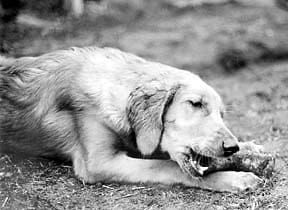Let’s get one thing straight: A dog’s gotta chew what a dog’s gotta chew. Dogs chew to exercise their jaws, to clean their teeth and gums, and to relieve boredom. It’s a completely instinctive and healthful activity. Once upon a time, dogs chewed happily on bones that were left over from our meals. However, this age-old practice has slowly changed as humans have come to rely (largely) on processed foods. Today, few home kitchens provide a steady supply of bones to the household dog.
As our eating habits changed, so have our perceptions of food safety. Over the years, real bones vanished from our dogs’ recreational and nutritional menu as “responsible” dog owners were advised to avoid them – something we are now coming to see was misguided.
Unfortunately, if a dog can’t chew one thing, he will chew another. We realized that one of our dogs’ most basic needs had been left unmet, and a billion-dollar market was born.
Aside from the original rawhide chew – of which there are innumerable brands and types available – there are now “sushi” chews, pig snouts, jerky-flavored turkey necks, and peanut-butter basted rawhide rolls. There are lamb ears, donkey hooves, and supposedly succulent pork “tenderloins” made from pig unmentionables. There are sterilized bones, smoked bones, plastic and rubber bones, and many petrochemical bones – one held together by a polymer similar to Elmer’s Glue.
But with the advent of the commercial dog chew market, the safety consciousness that led us to take real bones away has been diffused. While it is now easy to find products aimed at our dogs’ need to chew, in fact we know less and less about what they are made of – and, therefore, how healthy for our dogs they may or may not be.
How Regulated Are Chew Toys?
In theory, dog treats and chews are subject to an overlapping web of regulation. The federal Department of Agriculture oversees the manufacture of livestock feed and various agricultural grains. Our ultimate food authority, the Food and Drug Administration, examines the enormous family of food additives. The FDA’s Center for Veterinary Medicine investigates product health claims, such as dog foods classifiable as drugs, an d has published guidelines pertaining to edible dog products. The Federal Trade Commission regulates interstate business activities. The Environmental Protection Agency sets toxicity levels for food products and industrial production. And the Association of American Feed Control Officials (AAFCO) oversees the manufacture of dog foods.
We would like to assume that these regulators are watching over the interests of our dogs, that any products we can buy at a store to feed or entertain our dogs are safe, that independent laboratories are regularly analyzing those products for toxins and contaminants, and that product labels accurately represent what those products contain. Unfortunately, none of these assumptions would be justified.
In fact, to examine real-world government oversight of the pet food industry – from a consumer perspective, is to walk through the looking glass – into a legally-sanctioned yet unethical world where deception has been codified, where products are often both more and less than the sum of their listed parts. In the real world, none of these federal agencies exercise meaningful regulatory oversight of the pet food industry, much less the dog chew industry.
The best candidate for the job, clearly, is AAFCO. But for all practical purposes, AAFCO is a trade association. While AAFCO is comprised of state and federal feed control officials, as well as representatives of the feed industry, it is not a government agency, and adherence to its minimal nutritional standards is voluntary. From the perspective visible to the average consumer, AAFCO is almost solely concerned with establishing labeling definitions for dog food manufacturers subscribing to its standards.
A “Value Added Industry”
It’s meaningless to discuss the chew market without briefly addressing the larger picture of the dog food market, since they are parts of the same economic equation. Today, most pet foods are made by agricultural conglomerates, which maximize profits through the minimized waste made possible by vertical integration.
When animals and crops leave factory farms, they are quickly transformed into a vast range of commodities – in general, what humans eat or use, and then what’s left: grain tailings, stripped animal carcasses, and those animals deemed unfit for human consumption. Pet food brings some $10 billion annually into the economy, based largely on products that would otherwise be wasted as “unfit for human consumption.”
According to the Pet Food Institute, a commercial trade association, “The purchase and use of these ingredients by the pet food industry…provides an important source of income to American farmers and processors.” Few dispute the American farmer’s right to make a living, but many dispute the manner in which these ingredients are marketed.
In the mildest terms, low quality foodstuffs, often heavily preserved, are sold as something other than what they are. Controversial artificial preservatives like BHA, BHT, and ethoxyquin, which the FDA has designated as “generally recognized as safe” (GRAS), have been linked to canine health problems like heart and kidney disease, cancer, and immune disorders.
Manufacturers legally “hide” preservatives and other synthetic chemicals added by upstream suppliers – mills, rendering plants, etc. – whose organic products require preservation. They need list only those chemicals which they themselves add to a product. As a result, many manufacturers choose to market their products as “all-natural,” which may or may not be true by any reasonable understanding of those words, and which, in any event, carry no legal authority whatsoever.
Many of these products claim to be “healthy,” “premium,” “all-natural,” or “gourmet.” In fact, these products may or may not contain better or safer ingredients than products that don’t make these claims. According to the Food and Drug Administration, however, none of these claims have any official regulatory standing. Consumers are largely left to fend for themselves: The makers of “Treats and Chews,” as this market segment has been designated by the FDA, face significant oversight only at the level of permits required for production.
Chews Are Not Really “Food”
And since treats and chews are exempt, with the exception noted below, from AAFCO guidelines, we should briefly review the FDA’s guidelines regarding dog treats. As long as the product does not make claims of nutritional completeness (as some dog biscuits do) it is not required to list a “guaranteed analysis,” or any information other than net quantity, the manufacturer’s name and location, and the product’s list of ingredients, or single ingredient if that is not made obvious in the product name. Unfortunately, the issues for your dog are very serious. At the very least, manufacturers are unilaterally – and legally – making decisions about your dog’s long-term health, and not telling you what those decisions are, or how and why they were made.
According to Sharon Benz, an animal scientist at the FDA’s Center for Veterinary Medicine, “There is no pre-approval for food products required by the FDA, provided their ingredients are generally recognized as safe…It is the responsibility of the manufacturer/distributor to ensure the products they are placing into commerce are safe and in compliance with FDA regulations.”
It is only fair to state that human health is the FDA’s primary mandate; as Benz forthrightly stated, dog treats and chews are a “low priority.” In general, the FDA investigates overt product health claims and specific, documented consumer complaints.
Let the Buyer Beware
The message to dog owners here is: Caveat Emptor. It isn’t just a question of what your dog is eating for dinner. Most of us give our dogs treats and chews, and these often add up to a significant dietary factor. The fact is, we can’t be sure of what these products really contain, and whether those ingredients are safe. Until complete and honest labeling is required, dog owners should avoid those products with minimal, incomplete, or obviously deceptive labels – and when in doubt to contact manufacturers directly. Finally, use common sense. With a little practice, it is easy to spot the more absurd product claims: A length of bone filled with semi-moist meat by-products, with an implied shelf-life stretching to eternity, is not – and cannot possibly be – either all natural, or chemical free, in any reasonable understanding of those words.
Also With This Article
Click here to view “Hormone-Altering Chemicals: A Common Hazard in Dog Toys”
Roger Govier is a freelance writer from San Francisco, CA.






